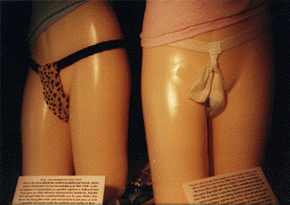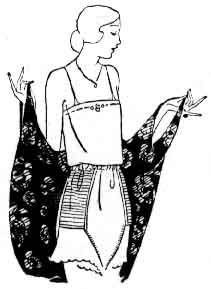See a roughly contemporary
pad, Society, and
a "silent purchase"
ad for Modess, 1928.
Other Modess ads:
1931,"Modess . . . . because"
ads, the French
Modess, and the German "Freedom"
(Kimberly-Clark) for teens.
See a prototype
of the first Kotex ad.
See more Kotex items:
Ad 1928 (Sears and
Roebuck catalog) - Marjorie May's Twelfth
Birthday (booklet for girls, 1928,
Australian edition; there are many links
here to Kotex items) - 1920s booklet in
Spanish showing disposal
method - box
from about 1969 - Preparing
for
Womanhood (1920s, booklet for girls)
- "Are you in the
know?" ads (Kotex) (1949)(1953)(1964)(booklet, 1956) -
See more ads on the Ads
for Teenagers main page


|

The pefect menstrual pad 3 (1 2 4 4a 5):
Belts, aprons,
step-ins, deodorant powder and cream
"Report of Gilbreth,
Inc.," to the Johnson & Johnson
Company, 1 January 1927, about
how to improve the company's menstrual
products, especially with regard to
competition with Kotex pads
|
 |
The
right
mannequin wears
an early 1990s Kotex
napkin belt, essentially
the same as one from the
1920s. Clasps hold the
pad to it, although pins
could be used.
(This was
part of the exhibit in
the actual MUM museum.
Take a tour!)
|
|
About half of the women who
responded to the survey used elastic belts (closest
mannequin in the photo)
to hold their pads in place and
usually could not remember what
brand it was. They overwhelmingly
used safety
pins to attach pads to
the belt - remember the Tampax ads
crowing "no pins"? - because
the clasps that came with many
belts could fail. And they avoided
belts that came apart to be
buttoned on, because they too
often failed. That meant that
women usually put the belt on over
their heads and wore them either
at waist or low on the hips. Some
women made their own from gauze,
elastic or ribbon.
Few women, 162, liked "sanitary
aprons" because they had a
rubber odor, faded or turned
yellow or gray with washing, tore
easily and slipped and twisted.
The report doesn't recommend rubber
bloomers, but seems to say
they are popular, [continued
below]
|
|

Above is a Hickory brand
step-in from an ad in
the June 1926 McCall's Magazine
(U.S.A.). From the ad: "Wear them
under your knickers this summer.
This style, in cool mesh and
light rubber . . . ."
(See Hickory
belts for pads.)
|
which might be a typo (it is not
an item in the statistics table).
They trap moisture, which is not
healthy. A high school faculty
member said, "The ideal thing
would be to get protection enough
in the napkin."
Gilbreth preferred rubber step-ins
(at left and here - 67
wrote that they used them) to
aprons and bloomers because they
didn't become hot or slip, "but it
is a nuisance to have to wear so
much rubber when only a little is
needed. . . . [A] small rubber
insert in the back . . . would
give ample protection."
Many women, 370, powdered their
pads, but just a few used Mum cream
(yes, Mum) or Amolin
powder deodorant.
|
|
The copy of the report that I
read, which might be unique,
rests in the special collections
of Purdue University, West
Lafayette, Indiana, U.S.A. Dr.
Gilbreth was the first woman
engineering professor at Purdue.
©
1999 Harry Finley. It is illegal
to reproduce or distribute work
on this Web site in any manner
or medium without written
permission of the author. Please
report suspected violations to [email protected]
|
|